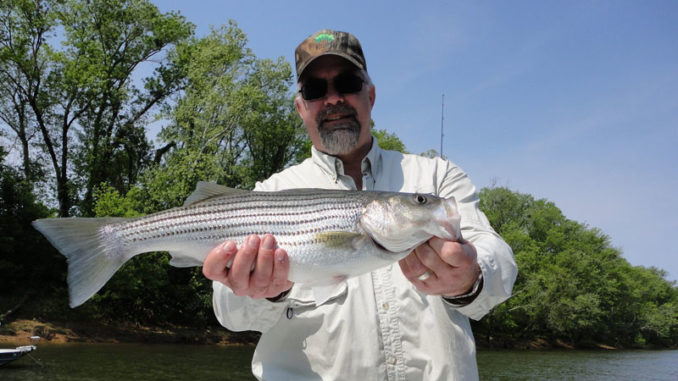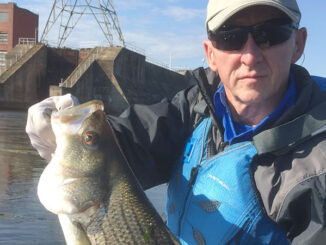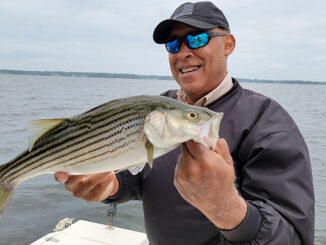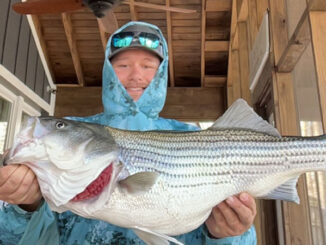
Springtime Dance
Mondays are my favorite days to fish the Roanoke in spring. Every Monday, N.C. Wildlife Resources Commission and N.C. Division of Marine Fisheries do their electrofishing survey. I usually take a Monday or two off from guiding clients in the late spring, and follow them around and shoot video for them.
Click here to watch “Striper Tagging on the Roanoke” video at captainponytail.com.
Without fail every spring, I see forty and fifty pound stripers shocked, tagged, and released unharmed. The first question my customers always ask is “why is it so hard to catch the big ones?” I must admit, it’s frustrating for me as well. It seems like somebody who fishes every day of the season between early April and late May would catch a big female once in a while, but nowadays if a twenty plus gets caught on a hook and line, it’s big news on the river.
I tell my fishing customers it’s just like the dances you used to go to when you were in junior high school. Remember? All the boys sat on one side of the gym in the bleachers and all the girls sat on the other side. After the band played a while, everyone eventually ended up in the middle of the basketball court trying to dance, but it always took a while for everyone to warm up to the idea.
Big stripers stick together
The striped bass on the Roanoke in the spring act the same way we all did when we were in the seventh grade. Pre spawn, they segregate by sex, and following along with N.C. Wildlife Resources Biologists year after year has proven that to me without a doubt. They follow a preassigned schedule of places they electrofish to establish a consistent baseline. They go to the same spots week after week and year after year, and the same thing always happens before the stripers spawn – when they shock up one female, they are likely to electrofish more than one from the same small spot.
On the video mentioned above, I saw NINE fish over forty pounds come to the surface in an area no larger than ten feet by ten feet. I just imagine those big fish on the bottom, slowly swimming against the current in ten or twelve feet of water, almost stacked on top of one another in a tiny area, just waiting for the band to play and the dance to start.
There are other reasons as well. There are so many smaller fish, usually males, that are willing to chase a bait, that I don’t think the bigger females who are less willing to fight with other smaller fish for food get many looks at your particular bait. Small males are like little kids on a playground, running around everywhere chasing after balls because it’s just fun and they have tons of energy to do it.
Weldon is a hotspot for a reason
Older veteran baseball players are willing to practice, but don’t want to chase around after hard grounders all day long. Capt. George Beckwith puts it simply, “Sperm is cheap”. I don’t have any scientific evidence to back this up, it’s all about what I see happening in my boat, but my guess is there are probably fifty males caught for every female. Most guides are a little more hesitant to keep a female as a result.
One other thing to consider if you’re targeting big fish on the Roanoke is this. If you spend eleven months of your life in the ocean seldom hearing a boat, and you suddenly find yourself in a ten foot deep tiny river with a hundred boats buzzing over you, I think you do what you can to get out of that environment. When it’s time to spawn those big females do come up to between the Weldon boat ramp and a mile or so downstream. These are the actual spawning grounds.
The fast water rapids that end with the set fifty yards above the Weldon ramp provide the perfect spawning scenario for the stripers, who seek out fast-moving water because that allows their eggs to float after they have been fertilized. But before and after the actual spawn, I think those bigger fish have a tendency to get away from that commotion between the Weldon ramp and Troublefield Gut a mile or so downriver.
Don’t miss the spring bite!
Some stripers lay up downstream, and some move up above that set of rapids you can see from the ramp in Weldon. Upstream is reserved for locals who know the river intimately, and for guys with jet boats who are used to navigating fast water. I go up there, but only when the outflow from Roanoke Rapids Dam is around the 20,000 CFS mark. Downstream, big fish find creek channels and mid current breaks to lay behind and relax, out of the main current of the river and away from all those boats.
Spring is coming on fast, and barring a cold snap that’s not predicted, I think it’s going to be an early season on the river. I know some locals who are already catching a few stripers from the bank at the boat ramp right now.
Greg Patterson will be bringing blueback herring to town to sell by next weekend. So get your equipment together and I’ll see you on the river early this year, and when you’re floating down the river and you cross a pile of huge arches on your depth finder and wonder if that’s a sunken tree because it just COULDN’T be a pile of big stripers all positioned that close together, you might want to put your foot on the trolling motor and check that out a little more closely. It just might be a giant pile of big girls putting on lipstick and talking about the boys just before they dance.
Catch ’em up!
Capt. Rod Thomas
Captain Ponytail Guide Service



